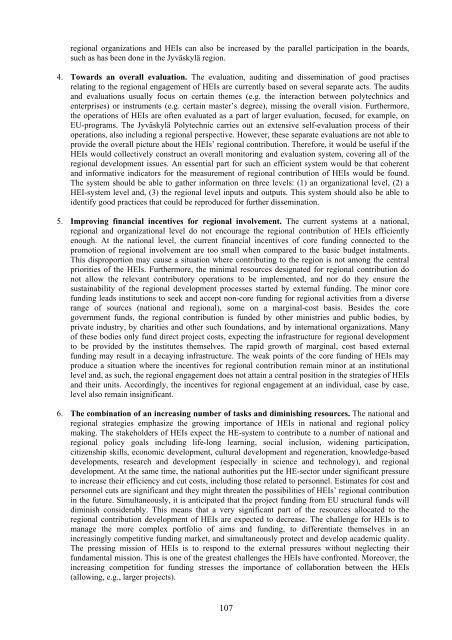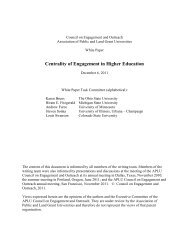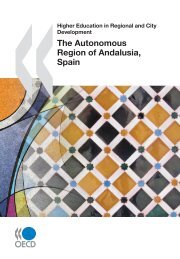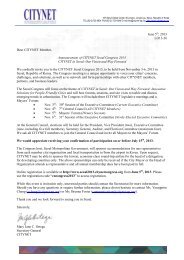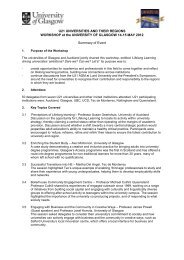Finland - Jyvaskyla Region - Final Self-Evaluation Report.pdf
Finland - Jyvaskyla Region - Final Self-Evaluation Report.pdf
Finland - Jyvaskyla Region - Final Self-Evaluation Report.pdf
Create successful ePaper yourself
Turn your PDF publications into a flip-book with our unique Google optimized e-Paper software.
egional organizations and HEIs can also be increased by the parallel participation in the boards,such as has been done in the Jyväskylä region.4.5.6.Towards an overall evaluation. The evaluation, auditing and dissemination of good practisesrelating to the regional engagement of HEIs are currently based on several separate acts. The auditsand evaluations usually focus on certain themes (e.g. the interaction between polytechnics andenterprises) or instruments (e.g. certain master’s degree), missing the overall vision. Furthermore,the operations of HEIs are often evaluated as a part of larger evaluation, focused, for example, onEU-programs. The Jyväskylä Polytechnic carries out an extensive self-evaluation process of theiroperations, also including a regional perspective. However, these separate evaluations are not able toprovide the overall picture about the HEIs’ regional contribution. Therefore, it would be useful if theHEIs would collectively construct an overall monitoring and evaluation system, covering all of theregional development issues. An essential part for such an efficient system would be that coherentand informative indicators for the measurement of regional contribution of HEIs would be found.The system should be able to gather information on three levels: (1) an organizational level, (2) aHEI-system level and, (3) the regional level inputs and outputs. This system should also be able toidentify good practices that could be reproduced for further dissemination.Improving financial incentives for regional involvement. The current systems at a national,regional and organizational level do not encourage the regional contribution of HEIs efficientlyenough. At the national level, the current financial incentives of core funding connected to thepromotion of regional involvement are too small when compared to the basic budget instalments.This disproportion may cause a situation where contributing to the region is not among the centralpriorities of the HEIs. Furthermore, the minimal resources designated for regional contribution donot allow the relevant contributory operations to be implemented, and nor do they ensure thesustainability of the regional development processes started by external funding. The minor corefunding leads institutions to seek and accept non-core funding for regional activities from a diverserange of sources (national and regional), some on a marginal-cost basis. Besides the coregovernment funds, the regional contribution is funded by other ministries and public bodies, byprivate industry, by charities and other such foundations, and by international organizations. Manyof these bodies only fund direct project costs, expecting the infrastructure for regional developmentto be provided by the institutes themselves. The rapid growth of marginal, cost based externalfunding may result in a decaying infrastructure. The weak points of the core funding of HEIs mayproduce a situation where the incentives for regional contribution remain minor at an institutionallevel and, as such, the regional engagement does not attain a central position in the strategies of HEIsand their units. Accordingly, the incentives for regional engagement at an individual, case by case,level also remain insignificant.The combination of an increasing number of tasks and diminishing resources. The national andregional strategies emphasize the growing importance of HEIs in national and regional policymaking. The stakeholders of HEIs expect the HE-system to contribute to a number of national andregional policy goals including life-long learning, social inclusion, widening participation,citizenship skills, economic development, cultural development and regeneration, knowledge-baseddevelopments, research and development (especially in science and technology), and regionaldevelopment. At the same time, the national authorities put the HE-sector under significant pressureto increase their efficiency and cut costs, including those related to personnel. Estimates for cost andpersonnel cuts are significant and they might threaten the possibilities of HEIs’ regional contributionin the future. Simultaneously, it is anticipated that the project funding from EU structural funds willdiminish considerably. This means that a very significant part of the resources allocated to theregional contribution development of HEIs are expected to decrease. The challenge for HEIs is tomanage the more complex portfolio of aims and funding, to differentiate themselves in anincreasingly competitive funding market, and simultaneously protect and develop academic quality.The pressing mission of HEIs is to respond to the external pressures without neglecting theirfundamental mission. This is one of the greatest challenges the HEIs have confronted. Moreover, theincreasing competition for funding stresses the importance of collaboration between the HEIs(allowing, e.g., larger projects).107


